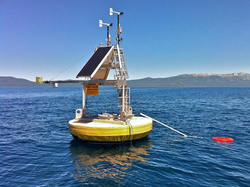News Detail
Climate change rapidly warming world’s lakes
December 22, 2015 |
More than 60 scientists took part in the research, published in the journal Geophysical Research Letters and announced today at the fall meeting of the American Geophysical Union. The study found lakes are warming an average of 0.34 degrees Celsius each decade. That’s greater than the warming rate of either the oceans or the atmosphere, and it can have profound effects, the scientists say. At the current rate, algal blooms, which can ultimately rob water of oxygen, are projected to increase 20 percent in lakes over the next century. Algal blooms that are toxic to fish and animals would increase by five percent. And these rates imply that emissions of methane, a greenhouse gas 25 times more powerful than carbon dioxide, will increase four percent over the next decade.
“Lakes are important because society depends on surface waters,” said co-author Martin Schmid, environmental scientist at Eawag. “Not just for drinking water, but also for energy production, for irrigation of crops, and for tourism. Protein from freshwater fish is especially important in the developing world.”
Ecosystems may not adapt to quick changes
Temperature is one of the most fundamental and critical physical properties of water. It controls a host of other properties that include intricate living processes that have evolved within strict boundaries. When the temperature swings quickly and widely from the norm, life forms in a lake can change dramatically and even disappear. “‘These results suggest that large changes in our lakes are not only unavoidable, but are probably already happening,” said lead author Catherine O'Reilly, associate professor of geology at Illinois State University. Earlier research by O’Reilly has seen declining productivity in lakes with rising temperatures.
Long-term measurements and satellite data
Funded in part by NASA and the US National Science Foundation, the study is the largest of its kind and the first to use a combination of long-term hand measurements and temperature measurements made from satellites, offsetting the shortcomings of each method. Satellite measurements provide a broad view of lake temperatures over the entire globe. But they only measure surface temperature, while hand measurements can detect changes in temperature throughout a lake. Also, satellite measurements go back only 30 years while some lake measurements can go back more than a century. A total of 235 lakes were monitored for at least 25 years. While that’s a fraction of the world’s lakes, they contain more than half the world’s freshwater supply.
Northern lakes with faster rising temperatures
The researchers said various climate factors are associated with the warming trend. In northern climates lakes are losing their ice cover earlier, and many areas of the world have less cloud cover, exposing their waters more to the sun’s warming rays. Many lake temperatures are rising faster than the average air temperatures. Some of the greatest warming is seen at northern latitudes, where rates can average 0.72 degrees Celsius per decade. Warm-water, tropical lakes may be seeing less dramatic temperature increases, but increased warming of these lakes can still have large negative impacts on fish. That can be particularly important in the African Great Lakes, home to one-fourth of the planet’s freshwater supply and an important source of fish for food. “We want to be careful that we don’t dismiss some of these lower rates of change,” said Schmid. “In a warm lake, a small temperature trend can have more severe consequences than a higher rate of change in a cooler lake.” In general, the researchers write, “The pervasive and rapid warming observed here signals the urgent need to incorporate climate impacts into vulnerability assessments and adaptation efforts for lakes.”
A combination of satellite data and ground measurements, such as from instrumented buoys like this one in Lake Tahoe on the California/Nevada border, were used to provide a comprehensive view of changing lake temperatures worldwide. The buoy measures the water temperature from above and below.
Credits: Limnotech


